A Note on Size and Fit:
Size and fit can vary between different brands or even different styles. Some brands make more than one fit in some garments, for example - slim fit, regular fit, or relaxed fit.
Where a brand has provided it, we have included an individual size guide for each item. Click or tap on the 'Size Guide' link at the right side above where you pick your size for more details:
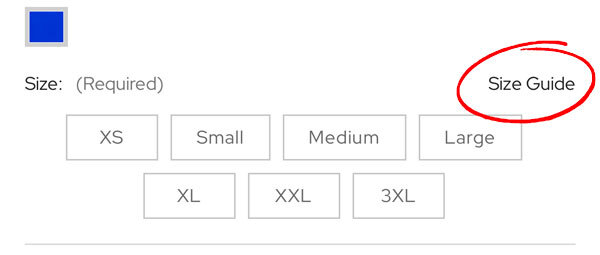
Size guides are approximate and for guidance only.
The fit of a garment may vary depending on the cut, style and fabric.
Measurements and sizing is based on each brand's individual guidelines and may differ from brand to brand.
Where there isn't a size guide showing, the brand has not provided any size info. Please contact us with any questions about sizing in that instance.
Measuring Guides & International Size Conversions:
Jump to section:
Shoes, Boots and other Footwear:
All shoes and boots are shown in UK shoe sizes.
International shoe size conversion can differ from brand to brand. For this reason please check the size guide for the brand found at the right side of where you choose your size, or refer to the info on the product page.
Hats and Caps:
Hat sizes are measured by the circumference of the brim of the hat, on the inside.
Here is a general size guide for hat size conversion:

Some styles/brands may differ.
How to measure your head:
1. Wrap a tape measure around the circumference of your head where you would naturally wear your hat. This will be approx. 1cm above your ears and should be slightly lower at the back than front.
2. Tighten your tape measure for how tight you want your hat to be. We recommend you don’t hold it too tightly though as there is usually no stretch in the hat headband. Generally hold it comfortably or just slightly loose.
3. Keep your finger where the tape measure meets and unwrap it. This is your hat measurement!
Tips:
- If you don’t have a tape measure, use a piece or string or similar in place of the tape measure and mark it where it meets around your head. You can then measure it against a ruler.
- If you’re in between sizes, size up to the larger size.
Mens Jackets, Shirts and Tops:
Mens Jackets, Shirts & Tops International Size Conversion:
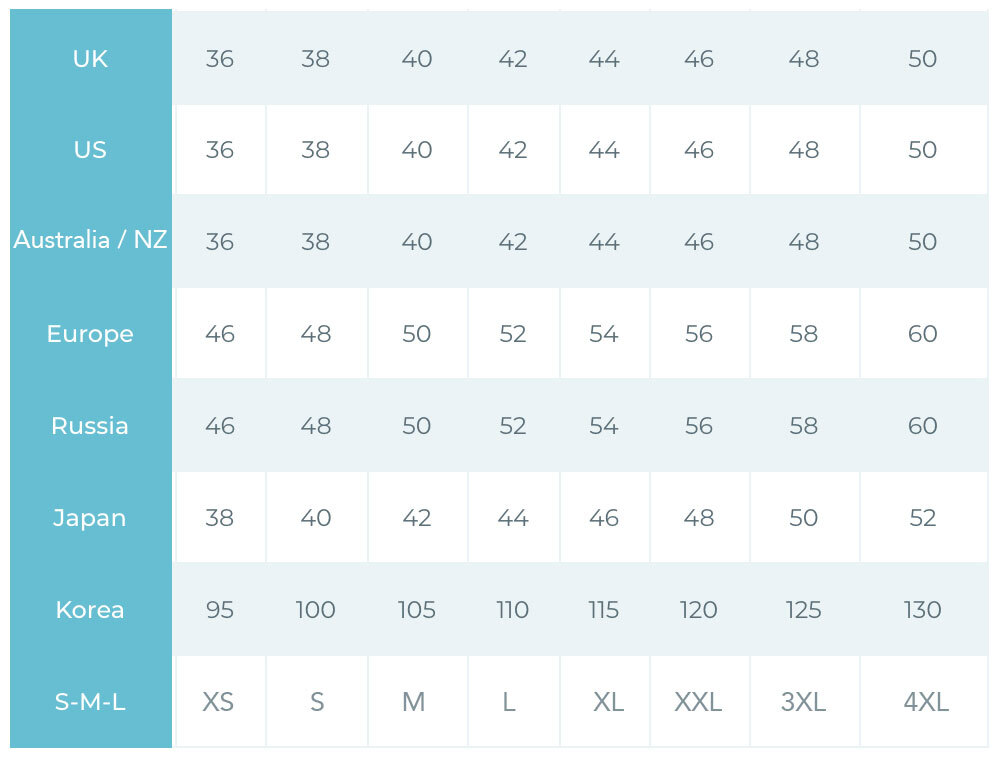
- UK, US and Australia / New Zealand sizing is in chest sizes in inches.
- The European size covers (among others) Italian, French, Spanish, German, Swedish, Dutch and Portuguese clothing size.
- Some brands can run slightly slimmer (more mod fit), so you might need to size up if you prefer a relaxed fit.
- Sizes on our website are shown in UK sizing.
How To Measure Your Chest Size:
What you’ll need:
-
A flexible tape measure (fabric or soft plastic).
-
A mirror (optional, but helps keep the tape level).
- Possibly someone to assist you take an accurate measurement.
How to measure chest size:
-
Remove bulky clothing – Wear a thin T-shirt or measure bare-chested.
-
Stand naturally – Relax your arms at your sides and breathe normally (don’t puff your chest out).
-
Position the tape – Wrap the tape measure around the fullest part of your chest, usually just under your armpits and across your shoulder blades.
-
Keep it level – Make sure the tape is straight across your back and not sagging or twisting.
-
Take the measurement – The tape should be snug but not tight. Note the number in inches or centimetres where the tape meets.
-
Check twice – Breathe in and out normally, then re-measure to confirm accuracy.
Tips:
- For men’s clothing, chest size usually corresponds to jacket, shirt, or coat sizes (for example, a 40" chest = size 40 jacket).
- If you are unable to measure yourself easily you can also compare the sizes to a jacket you already own and which fits you well. Measure the jacket laid flat and zipped or buttoned up. Measure straight across the jacket on the front from armpit to armpit, from seam to seam. Double the result and this should give you the chest size of the jacket. eg. If you measure 19" across the chest of the jacket, armpit to armpit, 19" doubled is 38", so 38" is the chest size of the jacket. Please bear in mind that different fits of different jackets may be tighter or looser cut, so it may be worthwhile measuring 2 or 3 jackets which fit you well to get a clearer idea of what size you need if you are using this method.
- Some brands can run slightly slimmer (more mod fit), so you might need to size up if you prefer a relaxed fit.
Shirt Collar sizes:
Some formal shirts are sized in collar sizes in inches. Roughly, these sizes convert as:
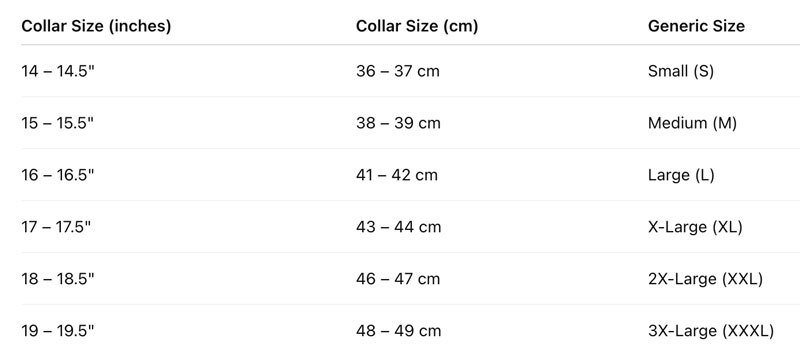
This is a general guide — exact fits vary by brand, but most follow this pattern.
To measure your collar size:
Place the measuring tape around the fullest part of your neck and keep the tape snug but not tight. For a comfortable fit, place 2 fingers between the tape and your neck. Round up to the next 1/2 inch.
Mens Trousers, Jeans, Flares And Pants:
Trouser sizes are shown in two ways, either waist and leg length or waist size with a letter to represent the leg length.
S - Short
R - Regular
L - Long
Here are some examples:
- 32W 30L
This size means 32 inch waist with a 30 inch inside leg.
34W 32R
This size means 34 inch waist with a 32 inch inside leg.
- 36S
This size means 36 inch waist with a short inside leg length.
30R
This size means 30 inch waist with a regular inside leg length.
International Trousers and Jeans Size Conversion:
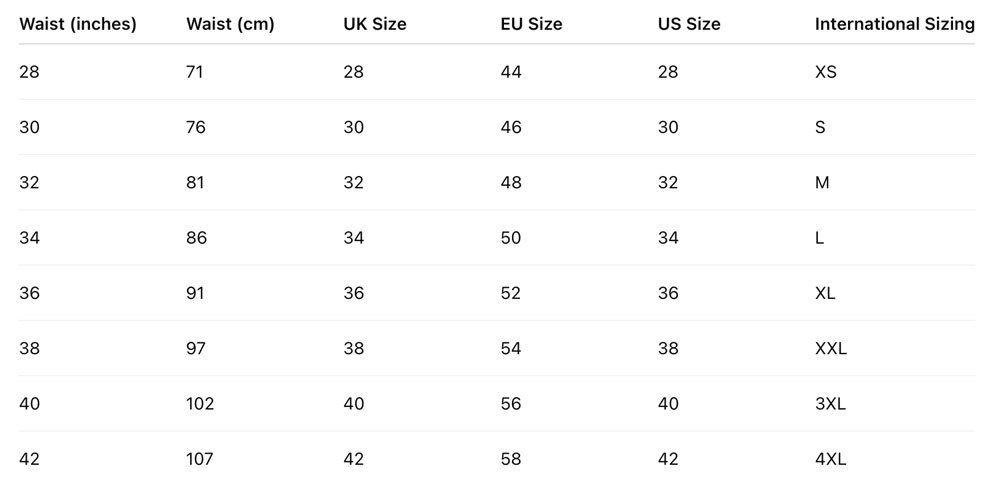
- This is a genaral chart which gives approximate conversions.
- Some brands may differ.
- If you're unsure of your waist size, it's best to measure yourself before you order.
How to measure your waist:
What you’ll need:
-
A flexible tape measure (fabric or soft plastic).
-
A mirror (optional, but helps keep the tape level).
- Possibly someone to assist you take an accurate measurement.
Where to Measure:
Most men’s trousers and jeans are sized by waist measurement taken around the natural waistline, but the actual waistband often sits a bit lower (on the hips).
How to Measure your waist size:
-
Wrap the tape measure around where you normally wear your trousers (for many men this is slightly below the natural waist).
-
Keep it snug but not tight — you should be able to slide a finger under the tape.
-
Stand naturally. Don’t suck in or push out your stomach. Stand relaxed to get a true measurement.
-
Read the measurement. Check the number where the tape overlaps. Record the measurement in inches — that’s usually the trouser waist size (e.g., 32", 34").
Tips:
- If you’re measuring for jeans or trousers, also check the brand’s size guide — some brands measure at the waistline, others slightly lower (closer to where the trousers sit on your hips).
- Measure around your waistline where you normally wear your trousers or jeans, keeping your forefinger between your body and the measuring tape.
- Trousers, Jeans and Flares sizes are equal to your waist size. For example, if you have a 32" waist, you should wear a size 32" jeans or trousers.
- Alternatively, you can measure the waistband of a pair of trousers or jeans which are a comfortable fit. Measure around the circumference of waist band with the trousers fastened and laid flat, this should give you the waist measurement of the garment.
Leg Length:
We currently stock 3 leg lengths in most styles. Here is a general size conversion chart for men's trousers and pants inside leg length.

Some brands size slightly differently, with 29", 31" and 33" inside leg measurements for short, regular and long.
Some styles will be slightly different. Check the size guide per brand for more info or the item description.
How to measure leg length (inseam):
The easiest way to measure leg length (inseam) is this:
-
Use a pair of trousers you already own that fit you well in the leg length.
-
Lay them flat on a table or floor.
-
Measure from the crotch seam (where all four seams meet) straight down the inside leg to the hem.
-
That number in inches or cm is your inseam/leg length.
-
-
If you want to measure directly on your body:
-
Stand straight with bare feet or shoes you’d normally wear with trousers.
-
Place the tape measure at the top of your inner thigh (crotch area).
-
Run it down the inside of your leg to the point where you’d like the trousers to end (ankle or shoe top).
-
Mens Suits and Tailoring:
How Suit Sizes Work:
-
Number (e.g. 40, 50, 100): Refers to the chest measurement in inches.
-
Letter (S, R, L): Where available this refers to the jacket length (Short, Regular, Long).
-
Trousers: Typically the trouser waist size is 6 inches smaller than the jacket chest size (e.g. A UK 40" chest jacket pairs with 34" waist trousers).
Approximate Length Guide (Jacket Fit)
-
Short (S): For men up to ~5'7" / 170cm
-
Regular (R): For men 5'8"–6'0" / 173–183cm
-
Long (L): For men over 6'1" / 185cm+
International Suit Size Conversion:
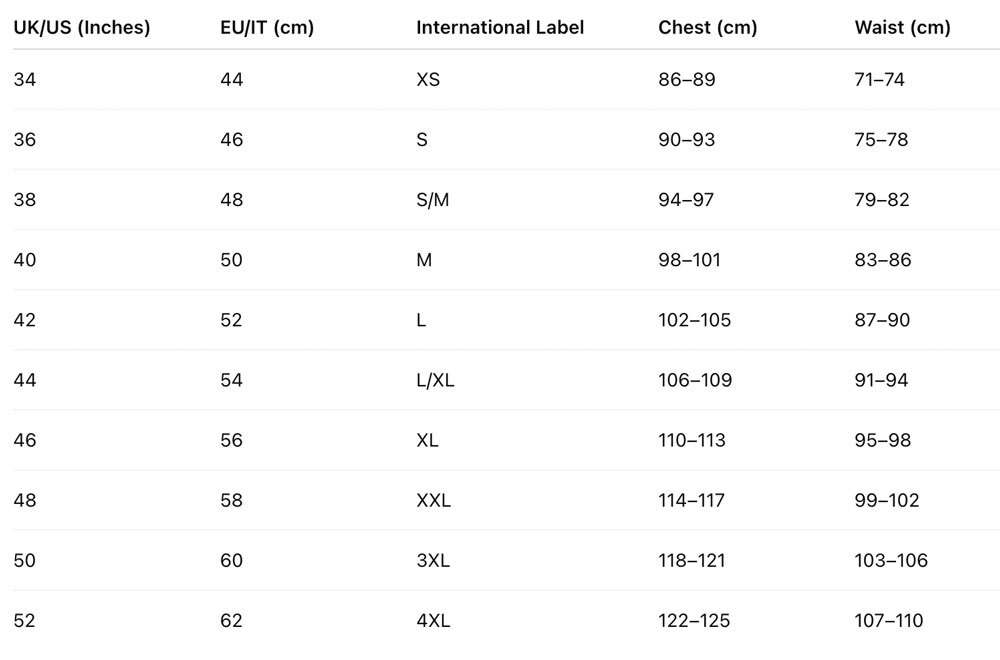
For help and information on how to measure your chest and/or waist, please see above.
Womens Sizing:
Unless stated otherwise, all our garments are shown in UK standard dress sizes.
Generic to UK sizing:
| XS | UK 8 / US 4 |
| Small | UK 10 / US 6 |
| Medium | UK 12 / US 8 |
| Large | UK 14 / US 10 |
| XL | UK 16 / US 12 |
| XXL | UK 18 / US 14 |
| 3XL | UK 20 / US 16 |
This guide is approximate and may vary from brand to brand.
Women's International Size Conversion:
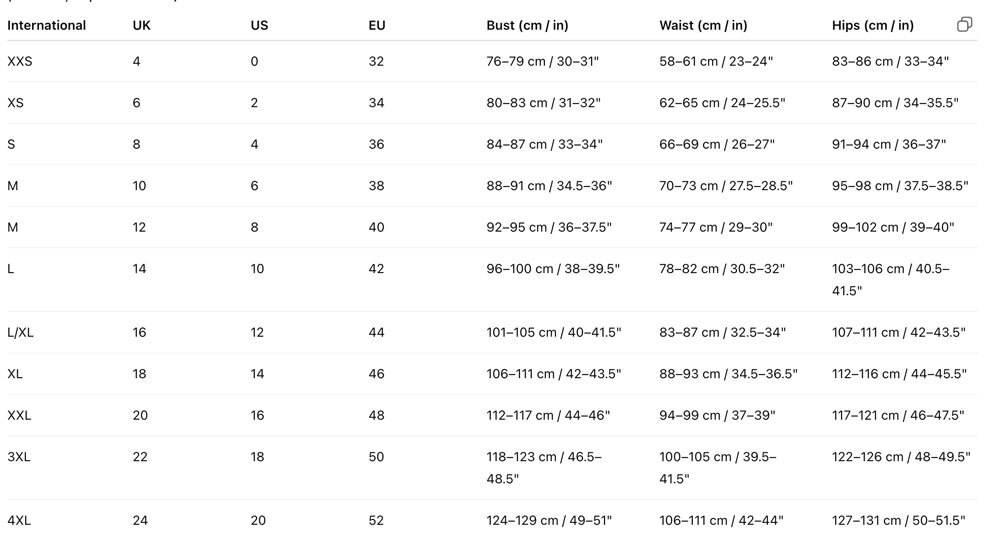
The above is a general and approximate guide based on standard sizing. Some brands may vary or differ from this. Please contact us if you have any specific size and fit questions.
How to Measure Your Chest & Dress Size (Women)
What You’ll Need:
-
A soft measuring tape
-
A mirror (to check the tape is level)
-
Close-fitting clothing or underwear
- Possibly someone to assist you take an accurate measurement.
Step 1: Bust (Chest) Measurement
-
Stand straight with arms relaxed.
-
Wrap the tape around the fullest part of your bust (usually across the nipples).
-
Make sure the tape is straight and parallel to the floor.
-
Keep it snug but not tight.
-
Example: 92 cm / 36 in.
-
Step 2: Waist Measurement
-
Find your natural waistline — the narrowest part of your torso, usually just above your belly button.
-
Wrap the tape around this point.
-
Keep the tape snug but comfortable.
-
Example: 74 cm / 29 in.
-
Step 3: Hip Measurement
-
Stand with feet together.
-
Wrap the tape around the fullest part of your hips/seat, usually 20 cm (8 in) below the waist.
-
Ensure the tape is level all the way around.
-
Example: 100 cm / 39.5 in.
-
Step 4: Compare to a Size Chart
Match your bust, waist, and hip measurements to our women’s general size chart (shown above) to determine your dress size.
Fit Glossary:
Quick Fit Guide Summary:
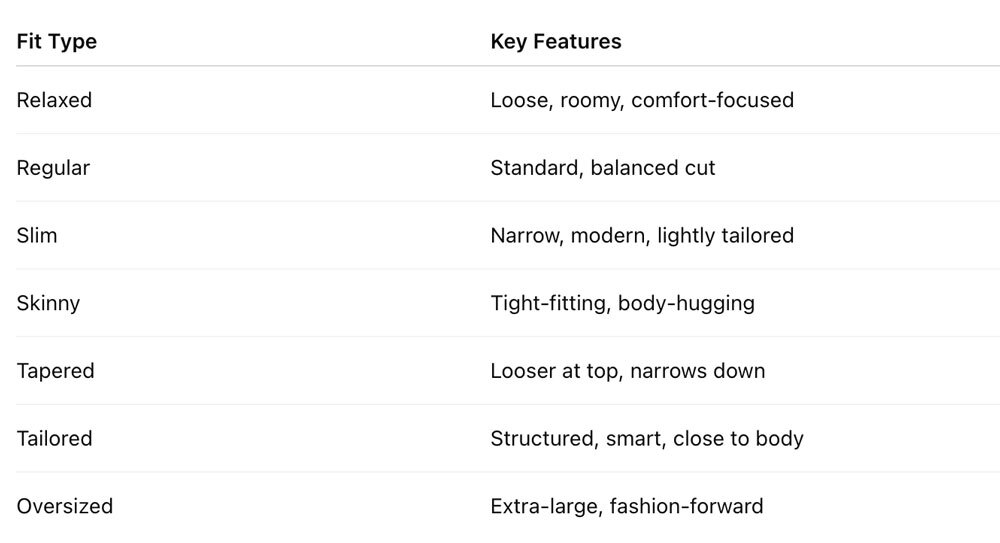
Common Clothing Fit Definitions
Relaxed Fit
-
Cut looser through chest, waist, hips, and arms/legs.
-
Prioritises comfort and ease of movement.
-
Often has a slightly boxy or oversized silhouette.
-
Example: vintage jeans, boyfriend blazers, oversized tees.
Regular / Classic Fit
-
Standard, straight cut — not too loose, not too tight.
-
Should follow the natural body shape without clinging.
-
Offers balance between comfort and style.
-
Example: traditional dress shirts, straight-leg trousers.
Slim Fit
-
Tailored closer to the body for a sharp, modern look.
-
Narrower through chest, waist, hips, and sleeves/legs.
-
Still has some ease — not skin-tight.
-
Example: modern suits, slim chinos, tailored dresses.
Skinny Fit
-
Very close-fitting from top to bottom.
-
Hugs the body, often with stretch fabrics for comfort.
-
Narrow leg openings / tapered arms.
-
Example: skinny jeans, bodycon dresses.
Tapered Fit
-
Combination of regular fit on top with slimmer shaping below.
-
For trousers: roomy at thigh, narrows at ankle.
-
For shirts/jackets: broader at chest/shoulders, narrows at waist.
Tailored Fit
-
Similar to slim fit but with more structure.
-
Designed to mimic custom tailoring (shaped waist, clean shoulders).
-
Often used in suits, blazers, and smart shirts.
Oversized Fit
-
Intentionally much larger than the body size.
-
Dropped shoulders, wide sleeves/legs.
-
Streetwear & high-fashion inspired.
Women’s Fit Extras
-
Bodycon: Very tight all over, accentuating curves.
-
A-line: Fitted at top, gradually widens towards hem.
-
Empire: Fitted under bust, loose over waist/hips.
-
Relaxed/Flowy: Light drape, minimal shaping.
